
Carolyn Weisnagel
4th Year, Art Education, Specialization
School’s out and TASK is in!
Video 1:24 min.
2014
In June of 2014, Concordia University’s Art Education Department hosted Brooklyn-based experimental artist Oliver Herring to create TASKmtl, a series of TASK parties which invited people of all ages to participate in improvised expression through art, messy play and interactive performance. In this two week intensive workshop our group collaboratively designed, engaged-in, documented, and compiled materials to include coordinated spontaneous networked communications for each TASK event through popular mass media sites such as Instagram, Facebook, YouTube and Pinterest.
To promote our Teen edition of TASKmtl, creating a targeted message directed at youth in the medium and visual form through which they communicate became an amazing task for reflecting on teaching practice. As a visual artist engaged in digital storytelling, establishing “a connection between the creator and the viewer,” and knowing your audience gives voice to engaging communication (Howland, Jonassen and Marra, 2012, p.227). As an art educator “making content and connections relevant to students’ lives helps bring meaning and purpose to instruction in all content areas” (Dreon, Kerper and Landis, 2011, p.7). Drawing on these essential principles I looked to my students as teachers and chose one of their favourite platforms: the Hollywood-style iMovie Trailer as the vehicle for inviting them to join us.
Conceptualizing celebrating the end of a school year with art-making, my video School’s Out and Task Is In! was easily supported by the Hollywood-style movie trope my students introduced me to during our issues-based L.E.S on stop-motion animated films. The Trailers allowed them to quickly edit clips into quirky themed templates during the postproduction phase of editing on their iPad in class, when Media Lab time was unavailable. The immediacy of its platform proved it to be a great tool for unpacking the more sophisticated desktop movie-making software platforms to come and allowed for practice working out timing of music, titles, transitions and credits for their films. At TASKmtl, personal stories influenced the tasks we wrote, performed, shared and collected.
My short trailer serves to build a greater story around Oliver Herring’s Socially Engaged Art and the inclusive vision and nature of collaborative art practices and TASK. My students’ way of knowing and storytelling “as actors who view, read, watch, play and often instruct their teachers about popular culture and media” has also helped me to reflect upon, evaluate and expand thinking about my own knowledge production and the dialogical relationship I have with students as cultural producers (Marshall and Sensoy, 2011, p.2). Created for: ARTE 398U TASKmtl.
References: Dreon, O., Kerper, R. M., & Landis, J. (2011). Digital Storytelling: A Tool for Teaching and Learning in the YouTube Generation. Middle School Journal (J1), 42(5), 4-9. Howland, J. L., Jonassen, D., & Marra, R. M. (2012). Meaningful learning with technology (4th ed.). Boston, MA: Pearson Education Inc. Marshall, E., & Sensoy, O. (2011). Rethinking popular culture and media. (1st ed.). Milwaukee, WI: Rethinking Schools Ltd.
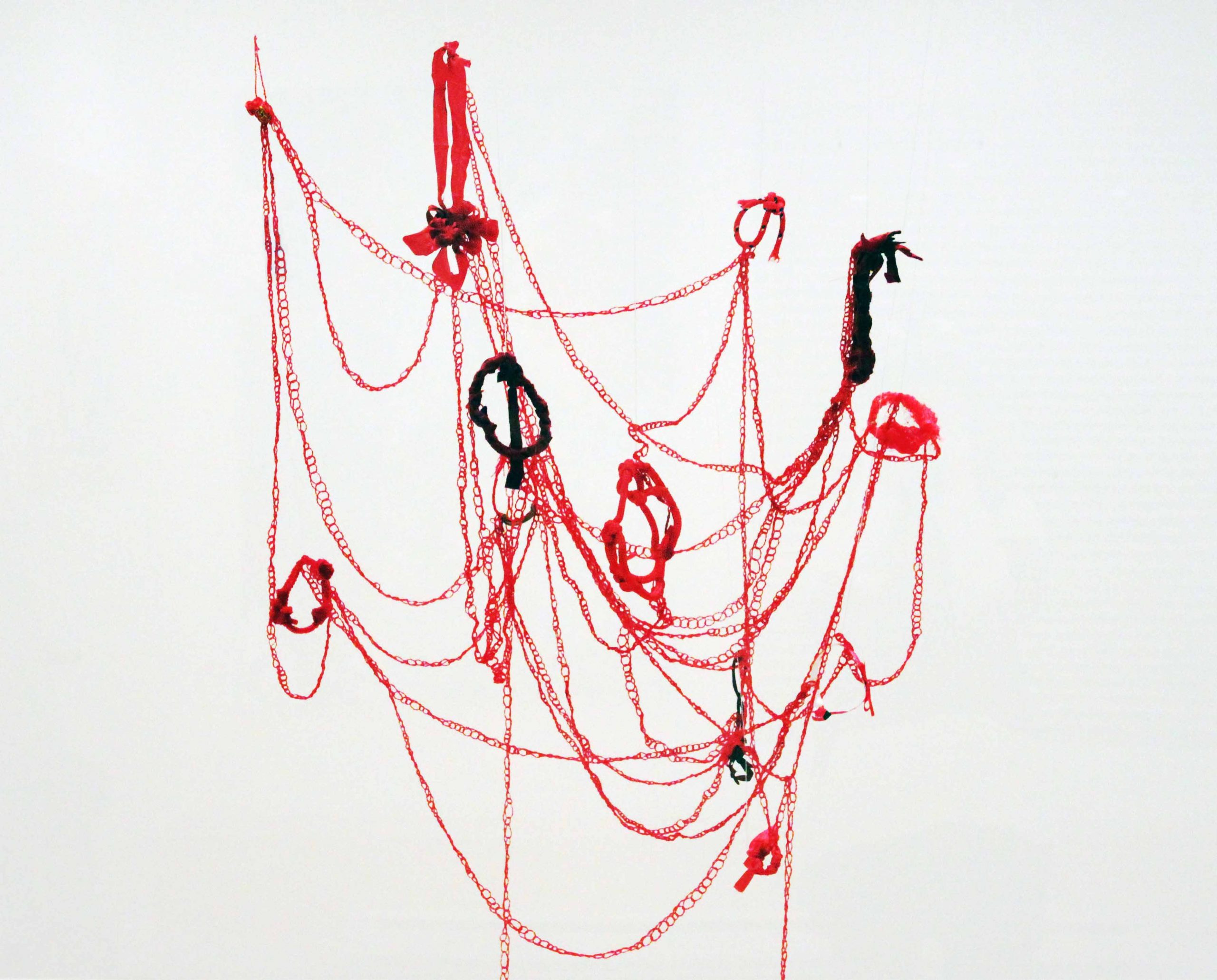
Yan Yee Poon
3rd Year, Community Art Education major, Psychology minor
Hanging By A Thread
Crocheted yarn and macrame knots with recycled/discarded items
approximately 51″ x 33″
2014
Hanging by a thread is an installation depicting a multitude of suspended red circles that are intertwined together through a chaotic cluster of red yarn; the work is a metaphor for the intricate and endless connections that we share with each other as part of the greater community.
Inspired by the Chinese proverb that “an invisible red thread connects those who are destined to meet, regardless of time, place, or circumstances,” the artwork brought together discarded items that people no longer wanted and transformed them into Chinese macrame knots to reflect the diverse meanings of the red thread in the Chinese culture. A single meticulously crocheted red yarn weaves in and out of the red hoops, bringing together the different stories and experiences embodied by the personal items. This infinite line symbolizes the countless invisible bonds that we share with one another. Each connection is distinct, illustrated through the intentional varied tensions in using different sizes of crochet hook. The personal becomes the public; the individual becomes a collective.
The installation is a continuous work-in-progress, inviting people to donate their discarded red items and see them transformed and joined in to an endlessly growing network of connections among individuals of dissimilar cultures, languages, and beliefs. Hanging by a thread was part of the Community Art Education collective exhibit UNFOLD at Pointe-St-Charles Art School.
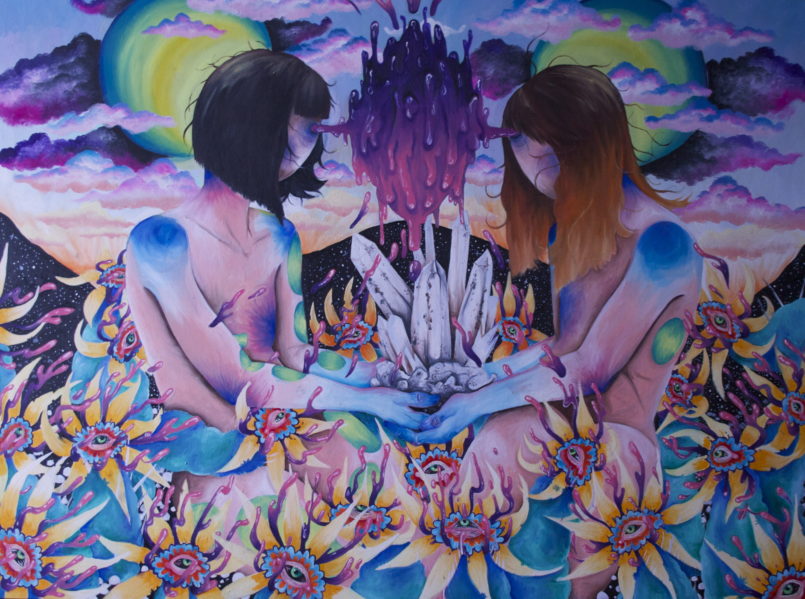
Katie Paglialunga
3rd Year, Art Education Major
Synesthesia Home Base
Oil on Canvas
36 inches x 48 inches
2014
Synesthesia Home Base is a narrative painting inspired by my oldest and dearest friend and the idea of “home.” When our class decided on a theme of home for our end of term exhibition I did not have a clear grasp on the identity of “my home”. I questioned if home was my apartment, if it was my childhood house, if it was a possession I owned or if it was a memory. As I pondered for an idea of something that was real my dearest childhood friend messaged me with so much enthusiasm, to commission me for a painting. I thought to myself, “This was it! This is the painting that will represent home for me, and how coincidental is the timing?” My friend Carly has been in my life for over a decade. We attended school together and our parents lived 10 houses down from each other. When we were younger there were many years we were inseparable, and I am sure we still would be today if we lived in the same province.
Carly and I both possess a neurological condition called synesthesia. The definition of “synesthesia is a neurological phenomenon in which stimulation of one sensory or cognitive pathway leads to automatic, involuntary experiences in a second sensory or cognitive” (Wikipedia). In both our cases, we see words, letters, numbers and even some sounds in colours.
In my painting Synesthesia Home Base, I have drawn this colourful glob emerging and forming from the humanoids figure’s third eye, representing our bond with synesthesia. Synesthesia Home Base expresses my feelings of how I view our relationship, as well as how I view myself and her, separately. The piece is bright, imaginative, childlike, personal, surreal and strange to help the viewer question and create their own narratives about the self in connection to others.
Reference: Synesthesia . Wikipedia. Retrieved March 20, 2015, from http://en.wikipedia.org/wiki/Synesthesia
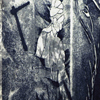
Ranya Saad
3rd Year, Art Education Major
To The War
(Printmaking) Etching on zinc with digital imagery effects
11.81 in x 15.75 in
2010
Literary themes have often served as a major source of inspiration for artists. In my practice, I am interested in transforming classic literary transcripts into contemporary conceptual visions. This artwork is one of a larger series recounting the story from Homer’s Iliad of The Golden Apple that led to the Trojan War. This story’s thematic relevance continues today to unmask and expose the tragedies and circumstances of war. The image of monochromatic cold colors imparts a sense of mystery and sadness married with a strong contrast in the lighting effects; this is designed to emphasize depth and texture.
To the war represents the story of Odysseus who, in the Trojan War, spent ten years fighting to retrieve the beautiful Helen. He then spent another ten years on the journey home to assume his rightful place as the King of Ithaca. While creating this series, my main concern was to reflect on war as a continuing by-product of desire for power and domination, and to depict the tragedy of distinct characters mired in confrontation. Although the Iliad was written around eighteenth century BC, the story suggests to me that not much has changed in modern times. While reading, I envisioned parallel stories of displacement and tragedy, which resulted in the production of these images.
**original image currently not available**
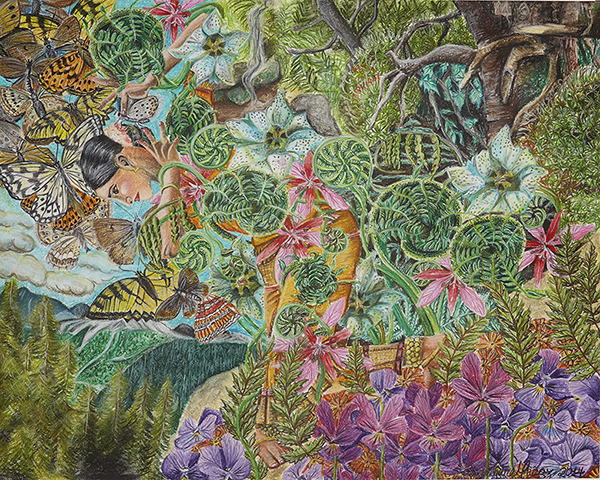
Sandrine Munoz
1st year, Art Education Major
Coiled Descent
Soft pastels and ink pens
57.6 cm x 72.2 cm
2014
Coiled Descent is the second piece in my collection of drawings of dancers and imagined landscapes. In the collection, I aimed to highlight the reciprocal relationship between the human figure and the environment and how this encounter between body and space results in a collective story. More specifically, the Indian dancer gliding through the coiled vegetation feels uncertain about transitioning between two worlds, the summit and bottom of the mountain. The organic forms surrounding her emphasize this struggle. However, she approaches this challenge with determination and looks forward without fearing the outcomes. The story embedded in this drawing is tied to my personal narrative. During the summer of 2014, I had the opportunity to visit many hiking trails. One of my adventures was particularly perilous. I had to face my fear of heights and take a leap of faith like the dancer of Coiled Descent when I descended the steep flank of Mount Sutton, a mountain located in the Eastern Townships, Quebec. As a result, I experienced mixed feelings; I was afraid of losing control but also felt that I could keep my balance by hanging onto the vegetation. This emotional tension is what I set out to explore in this series.
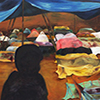
Gabisha Giritharan
4th Year, Art Education, Specialization
Loss
Oil on Canvas
48” x 40”
2014
Art holds the power to reveal stories and create dialogue. This painting is part of a series focused on a 26-year civil war that took place in northern Sri Lanka. The paintings intend is to reveal the loss of the people affected, not only by the loss of family and friends but also the loss of their homes, rights and privileges. Consequently, the paintings are meant to serve as a method of awareness, in order to connect viewers to the various effects of the civil war.
The images create a narrative to inform viewers of events that took place during the final months conflict. Although officially the bloodshed had ended in 2009, the repercussions of this conflict continue, leaving mental and physical burden for the Tamil people today. Many resources were used to create this series. The stories were collected through media, photographs, documentaries, news reports, as well as from relatives and friends. I don’t think there was a particular story that influenced my work but the effect and consequences of the war.
The creative process involved understanding countless stories from the past and present, one by one uncovering the horrors of the time, in order to share with others through art. Stories create an impact; visuals create a greater impact.
**original image is currently not available**
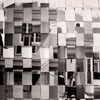
Yan Yee Poon
3rd Year, Community Art Education major, Psychology minor
Revisiting Memories
Photographic print (using a 35 mm film and processed in dark room)
9.8″ x 7.9″
2014
Revisiting Memories weaves the past and the present through the juxtaposition of two photographs. One photograph shows my two sisters and I standing at the front door of our home in Brossard; the second captures the same scene, without the figures, 20 years later. Both pictures were made using the lens of the same SLR camera my dad used to document the beginning of our journey in Montreal, when we first immigrated to Canada, 24 years ago. The fragmented aspect of the work effectively captures the complexity of memories, blurring the boundaries between the truth and the constructed, and merging them together to create a reality that becomes our own personal story of who we are.
**Original image currently not available**
Elsa Charpentier
3rd Year, Art Education Major
The Conscious Knowledge Sharer that I became ou Ce que vous voyez ce sont les pensées qu’un autre être humain a laissées sur terre
En ce qui a trait à l’enseignement des arts, mon approche est à la fois axée sur l’étudiant(e) et sur ma propre présence en tant qu’artiste et enseignante. C’est une rencontre où le pouvoir est partagé. Je vois la classe comme un studio, un atelier, un salon où je suis la première responsable de l’accueil, du bien-être des participants. Dans cet espace, je m’emploie à stimuler la qualité des échanges sur une base d’autonomie et d’autogestion guidée dont l’accomplissement, que ce soit dans l’expérience partagée ou en ce qui a trait l’œuvre finale, est collectif. Je crois à l’art par projets, forme qui, selon mon expérience, stimule et soutient la créativité. J’aime présenter des connaissances historiques et contemporaines, trouver de nouvelles façons de faire, d’apprendre, de concevoir. La générosité stimule la générosité et les expériences d’art qui prennent place sur de pareilles bases sont, comme le révèle l’engagement des étudiant(e)s, lumineuses. Je suis diplômée du programme d’enseignement des arts dans la Communauté de l’Université Concordia, un laboratoire de recherche intellectuelle soutenu par une application théorico-pratique constante sur le terrain. J’ai pu mener une réflexion critique et constructive liée à l’enseignement, repenser les lieux communs, les structures en place et améliorer consciencieusement ma contribution intellectuelle et sociale en tant que penseur(e) et professeure/éducatrice des arts. Comme le rapporte Deborah Barnt (2008) qui cite Cajete (1994) ”Community arts, as a term and recognized field of practice, only came into currency in the latter part of the 20th century, but the process it refers to-the engagement of people in representing their collective identities, histories, and aspirations in multiple forms of expression-is as old as cave paintings and ritualistic chanting.” (p.351). En réalité, donc, tout enseignement advient dans la communauté. Afin d’établir la qualité de l’enseignement dans le domaine des arts, il est nécessaire d’établir un critère quant à ce que l’on recherche. La question de la nature de l’art doit donc être posée. Selon Gibb (2012) ”A work should be moving or exciting or disturbing-somehow emotive-or it fails as a piece of art.” (p.240). C’est là une des exigences délicates qu’il est permis de poser vis-à-vis de l’art, médium où chacun est libre d’exercer sa sensibilité particulière, sociale et culturelle. Cependant, comme le fait valoir Ian Heywood (2009) ”Freedom is not a term one often encounters in today’s artspeak” (p.197).Les tentatives de définition de l’Art à travers l’histoire de l’humanité depuis l’antiquité démontrent que singulier ou pluriel, l’Art (s) possède une nature indéfinissable, polymorphe, jamais sujette au consensus, ce qui en fait un sujet, voire même un objet, de liberté des plus complexe à aborder en matière d’enseignement. C’est cette complexité intrinsèque que j’ai décidé d’inclure ouvertement dans mon cheminement professionnel. Heywood (2009) écrit aussi que ”There is […] a strong […] sense of art practice as part of a search for somewhere else’, somewhere where I can be if not exactly myself at least in touch with what really interest me.” (pp.197-198). Un quelque part, un lieu, un moment, un état, un espace, un endroit où l’existence rencontre l’essence. En tant qu’enseignante en art dans la communauté, je considère, par conséquent, tout étudiant(e) comme quelqu’un qui apporte son bagage, où tout est bon, où rien n’est à jeter.
En tant qu’artiste-éducatrice, pour reprendre les paroles de Gibb (2012), j’aborde les étudiant(e)s ”en tant qu’égaux autant artistiquement qu’intellectuellement”(p.239)afin d’installer un contexte où l’énergie circule mieux, où l’apprenant(e)/participant(e) est mieux disposé(e) à exercer une présence et un pouvoir d’action positive, un lieu qui mène au Monde, comme le fait valoir le magnifique exemple du mouvement Room 13, présenté par Gibb (2012), (pp.237-244). Je conçois ainsi l’espace d’enseignement en tant que lieu de construction et de partage de connaissances où je questionne les besoins de l’étudiant(e) (needs-based inquiry).
Ma présence en tant qu’enseignante est multiple et variable. Que je tienne le rôle de guide, d’ambassadrice des arts, de mentore, de facilitatrice, de complice, en ce sens l’art, est un allié, un ingrédient au puissant pouvoir de transformation et ma mission est de permettre aux participants d’actualiser ce pouvoir créatif en eux. Comme pédagogue, pour paraphraser Paulo Freire (1982) tel que cité par Gibb (2012), je crois au rôle du dialogue en éducation dans la communauté. (p.241). Mon approche est holistique ce qui se traduit par la création d’un lieu de rencontre ouvert, que je délimite par une atmosphère physique et intellectuelle – de la musique, du thé ou de quoi s’hydrater, la possibilité de se déplacer dans la pièce, un lieu de travail mais aussi d’inspiration à la mesure des besoins de chacun(e). Mon rôle, est de créer un espace stimulant, engageant, créatif, avec l’accès au matériel nécessaire qui sert, au sens où l’entend Heywood (2009) ”the approach ‘making’, ‘to make arts” (p.195). Ainsi, lorsque, par exemple, je propose un projet de fabrication de zines, ou d’épinglettes d’art ou d’écriture d’haiku et de fabrication de papier marbré, j’apporte au studio une ample diversité de matériel, car la variété est à mon avis nécessaire pour que toutes les sensibilités artistiques puissent s’engager le plus entièrement et authentiquement possible. Il y aura de quoi imprimer, découper, coller, peindre, lire, contempler, réfléchir, des encres, des crayons de toutes sortes, des outils pour l’inspiration, pour stimuler la créativité, pour explorer, pour que l’apprentissage soit aussi naturel et adapté que possible. Tout est entrepris d’une manière ‘hands on’ et des notions indispensables techniques, intellectuelles et culturelles sont abordées de manière organique.
J’ajouterais que l’enseignement dispensé se doit d’être de la plus haute qualité. Je crois au moyen comme au résultat ainsi qu’à l’importance de matérialiser et de donner forme à l’abstrait. Je crois aussi à l’expression plastique et intellectuelle.
Selon Heywood (2009), la classe offre ”the presence of a [small] audience capable of enjoying and appreciating works [that many would dismiss or ignore]” (p.198). Un lieu donc pour faire de l’art mais aussi pour ‘le mieux penser’ dans un contexte où chacun peut se réaliser et partager le meilleur de soi, c’est-à-dire la singularité, l’authenticité, l’ouverture, le goût d’exister et de traduire cette pulsion vitale par un acte créatif, générateur d’idées dans un lieu de dialogue ouvert.
(Documentation photographique en appendice)
Bibliographie
Barndt, D. (2008). 29 Touching Minds and Hearts: Community Arts as Collaborative Research. In Handbook of the Arts in Qualitative Research: Perspectives, Methodologies, Examples, and Issues. (pp. 352-364). Thousand Oaks, CA: SAGE Publications, Inc. doi: http://dx.doi.org/10.4135/9781452226545.n29
Cajete, G. (1994). Seeing the voices of our heart. In G. Cajete, Look to the mountain: Art ecology of Indigenous eductation. Kyland, NC: Kivaki Press.
Freire, P. (1982). Pedagogy of the oppressed. New York: Continuum.
Gibb, C. (2012). Room 13: The Movement and International Network. The International Journal of Art & Design Education, 31(3), 237-244.
Heywood, I. (2009). Making and the teaching studio. Journal of Visual Art Practice, 8(3), 195-204.
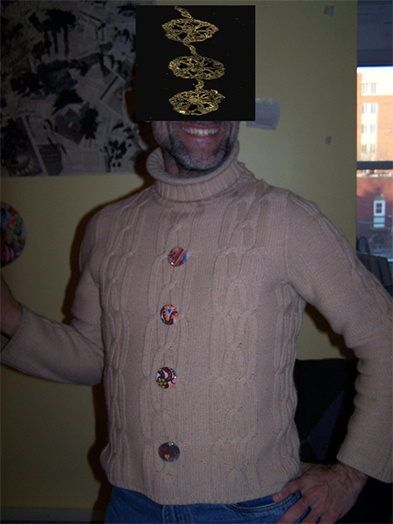

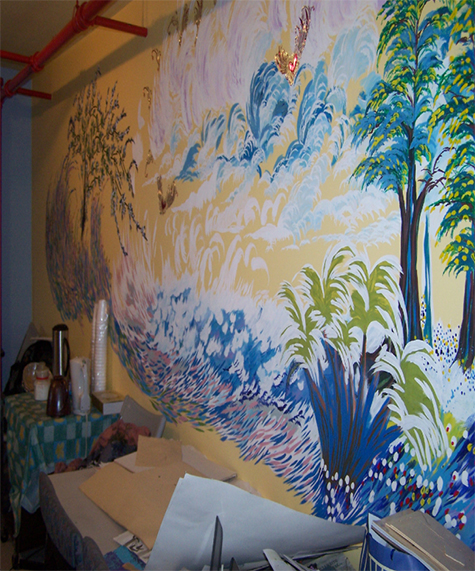
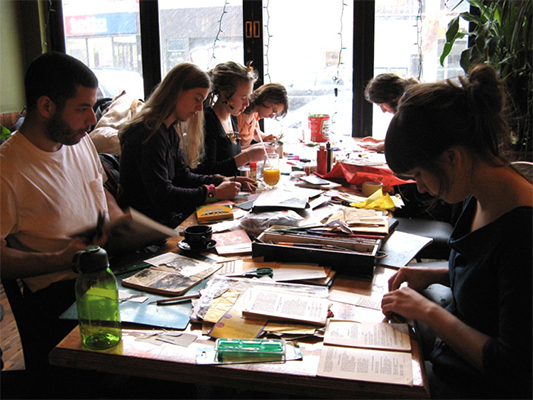
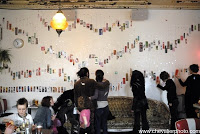
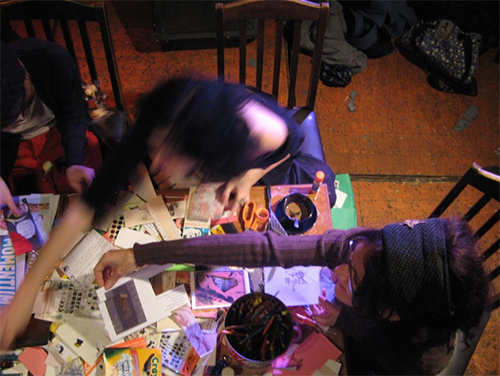
Rosi Maria Di Meglio
2nd year, Art Education
TASKmtl: performance, improvisation
It was the summer of 2014; I was not sure what I was getting myself into when applying for Exploring TASK, the week-long intensive art-making party hosted by the Art Education department last summer during the Hemispheric Institute’s Encuentro meeting in Montreal. I didn’t know who TASK founder Oliver Herring was and, at the start, I didn’t really care. I was interested in completing the class and getting my three credits.
As a mother of six young children and a full-time undergraduate student, I was looking at time management more than anything else. My goal was to complete my degree as fast as possible, and this three-credit summer intensive seemed to fit the bill. I had no idea. TASK creates a controlled environment that encourages performance and human interaction. And did I say it was fun? Founded by the American multidisciplinary artist Oliver Herring in 2002 began organizing a series of participatory improvisational art events known as TASK parties. TASK appears from the outside as chaos and wildness or festival and rave. But I learned to see it as a collaborative, improvisational social experience wherein those who take part can take chances, explore and experience art making without any expectations.
Imagine entering into a once-familiar space—the undergraduate Art Ed studio—now completely transformed via a carefully arranged collection of materials inviting us to start making. Stacks of paper; tonnes of cardboard and fabric; egg cartons and duct tape; markers and paint; glue guns and glitter: the range of creative material and its meticulous placement beckoned involvement. The space was completely transformed into a positive, energetic haven, in which smiling faces, disco music and welcoming strangers assured you, “It’s okay to paint on the walls!” And, “It’s okay to talk to strangers.” When I asked the artist about his work, he told me that, “TASK has two rules: 1. You write a task and put it in the box; and 2. You complete a TASK that you’ve taken from the box.” I found that, actually, TASK has many rules. Now, being the control freak that I am, I could appreciate the anal tendencies involved in setting-up for TASK; anarchy needs organization to be successful. Oliver had a specific method, and we needed to follow it to the letter, but there was a reason for his madness!
The set-up was extremely important, and Oliver explained to me why. When setting up the materials, it needed to be aesthetically pleasing; the materials were not the only part of the setup—the floor, walls and windows all had to be completely covered with white paper. Oliver believes that those first impressions guide the respect of the TASK participants. The Art Ed studio was transformed, but once completed think of the room as an exploded art studio, or three-dimensional sculpture, it was unbelievable! I could not anticipate what this ten-day long art experiment would do for me, or how it would help me discover who I am and what I can accomplish by collaborating and opening up to others. Growing up in the west island in a strict Italian family with over-bearing immigrant parents taught me to be a martyr. I experienced multiple forms of abuse; I survived it, but taught myself to be on guard with others. As an art educator, I realized I had created a huge wall around myself, controlling what people could see and keeping the rest hidden. I came to TASK as an outsider, but being in this community allowed me to see another side of myself.
For me, TASK became an opportunity to be completely honest with myself: I kept a journal throughout the experience; I made new friends and met many other students at the university and those attending the Encuentro event; and I completed a lot of tasks: for example, creating a press release and reaching out to my contacts and asking those supports for help was huge for me, especially asking for help. I wrote the press release to generate interest with the media and get the word out to as many people as possible. The word “intense” comes to mind, with only four hours to produce and release to various media contacts, including CTV. Wow–it was a great experience! I see this as being an important tool for elementary school kids, who are growing up and into the world. The intense realities of my own youth affected my confidence and my view on academics, limiting a sense of what I was capable of and allowed to accomplish.
As a teacher, I learned that I could make a difference for students in public schools who may be confronting similar hardship or challenges, as I did when I was young. I believe TASK has a place in our education system, whether it be as a model taught to teachers or as a model teachers share and do with their students. It has a place in our art education because it reminds us that anything can become possible!
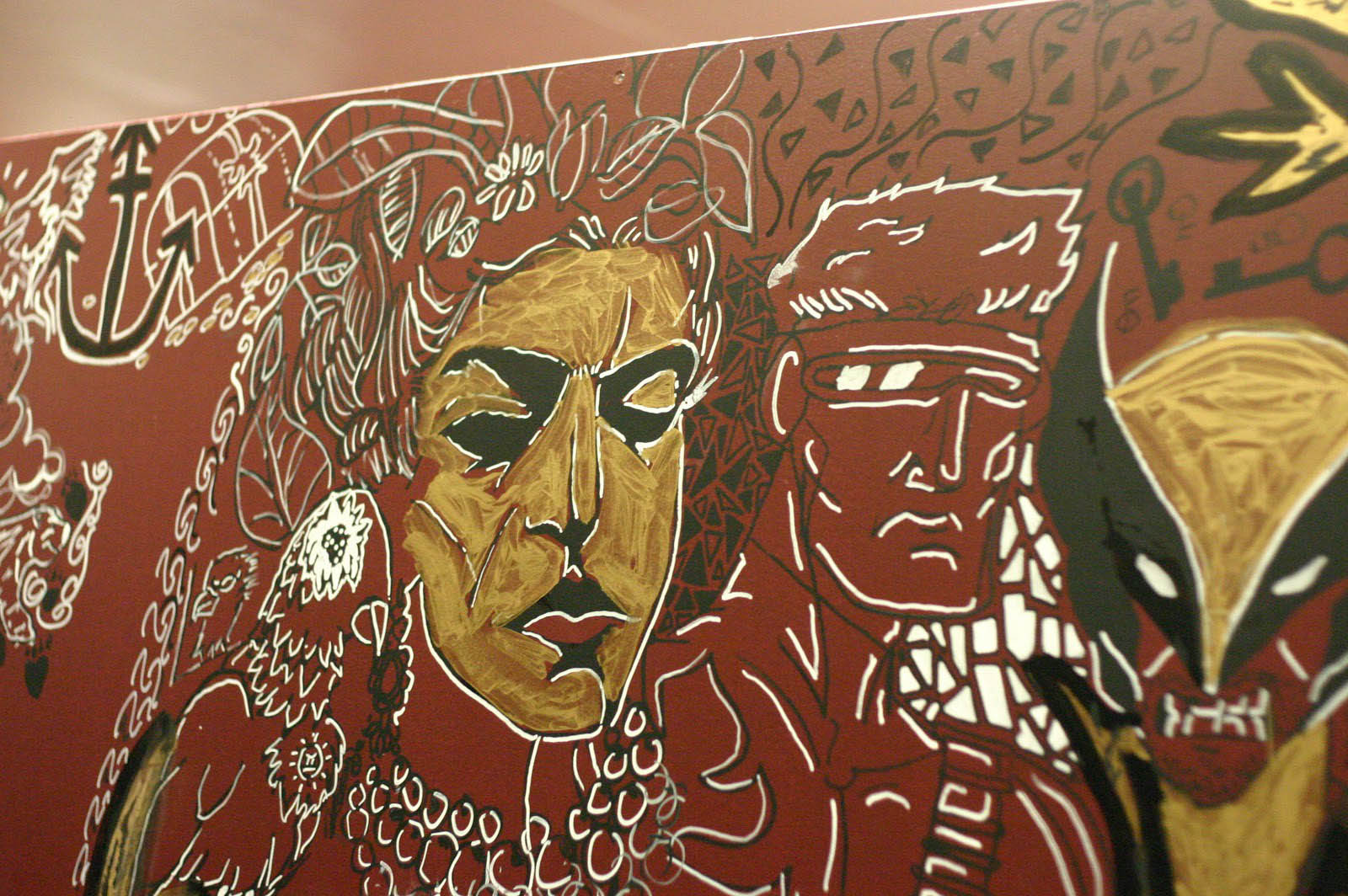
Fig. 2. Detail: “ Brian’s “Giles” on Know the ledge mural by James Lyng’s Urban Arts After School Program, Acrylic Paint, 2014
Christina Marie Phelps
4th year, Art Education Specialization
“KNOW THE LEDGE”: A high school’s narrative mural project
“You got to know the ledge to wise the dumb and understand your culture of freedom”
– Brand Nubian

Fig. 1. Collaborative Know the The Ledge mural by James Lyng’s Urban Arts After School Program, Acrylic Paint, 2014
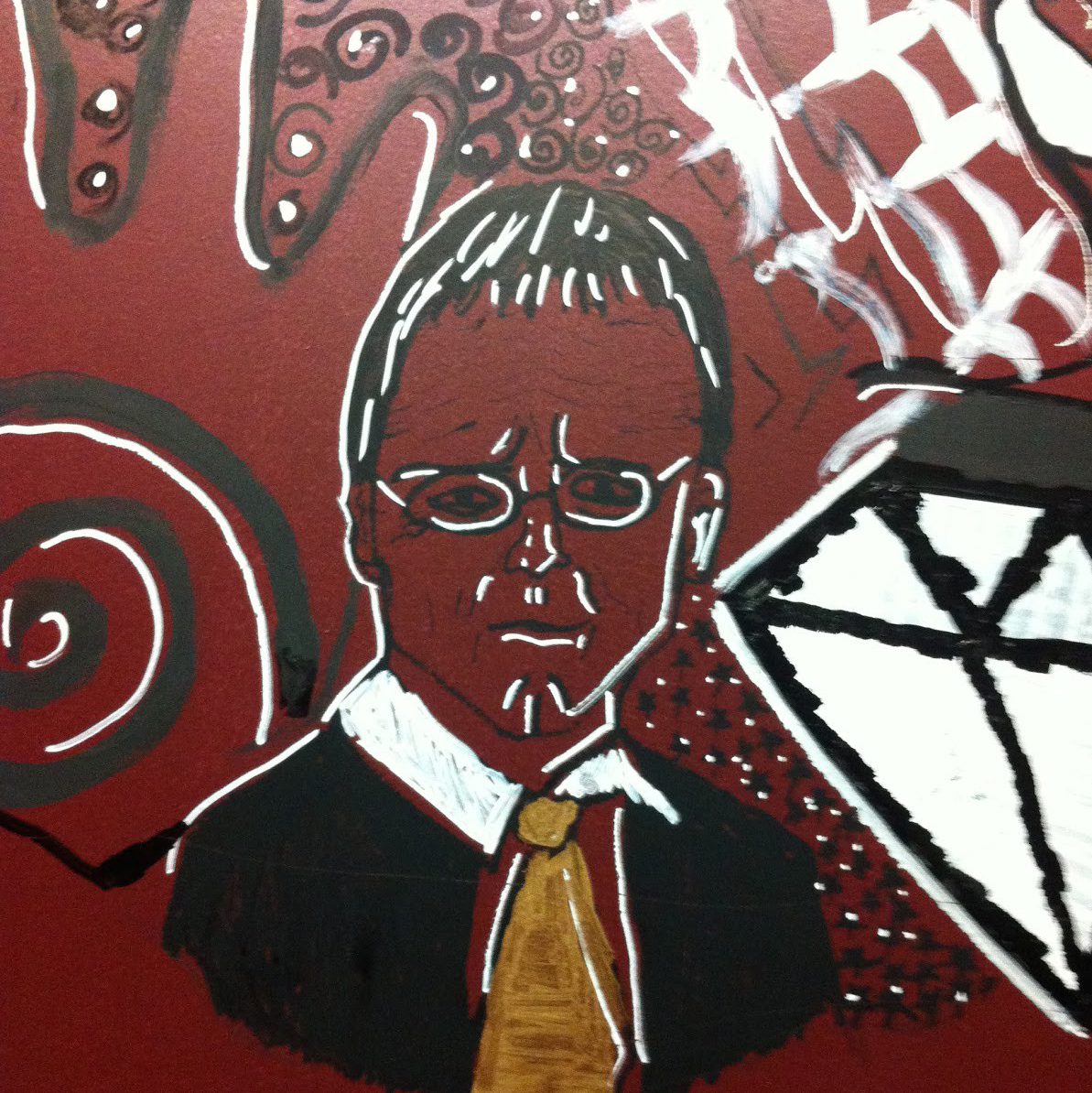
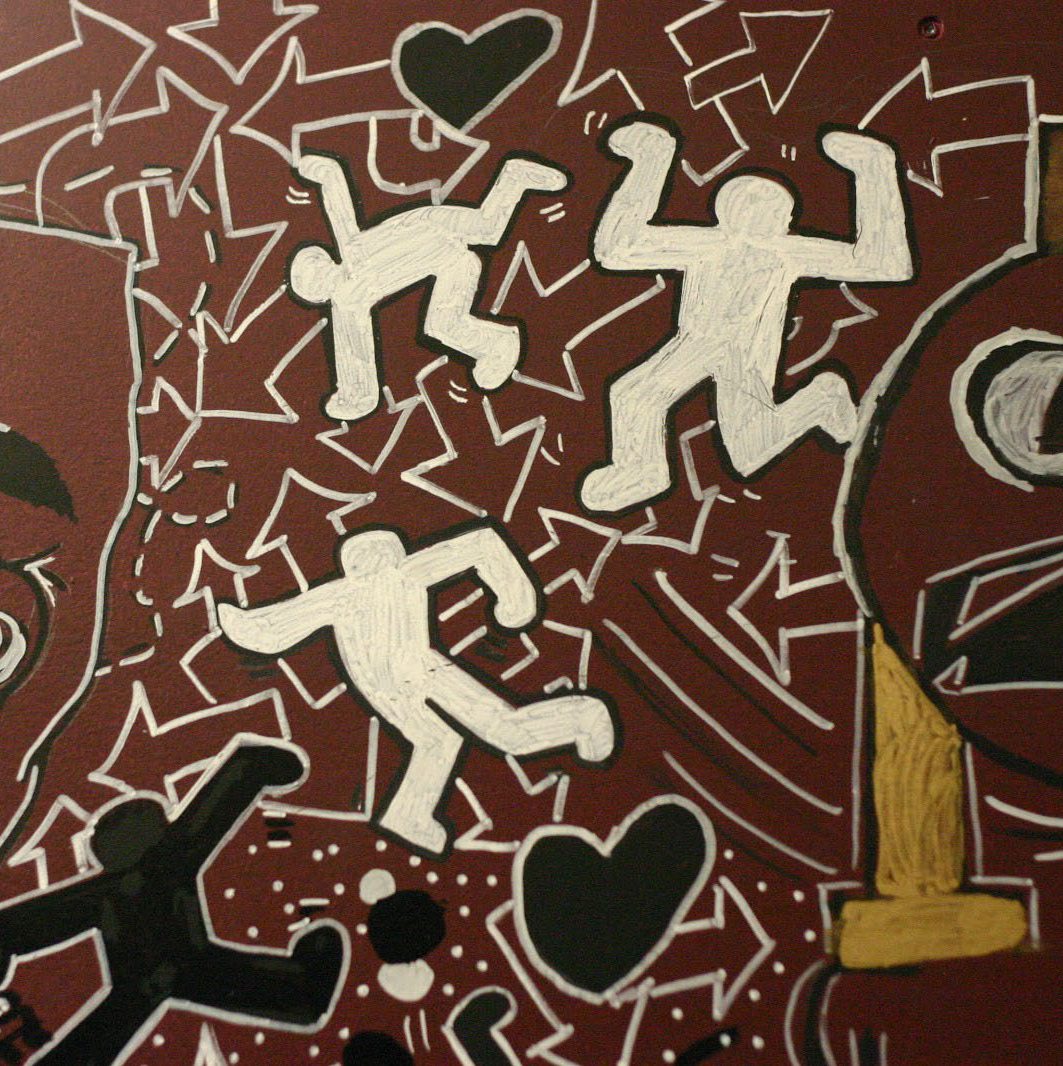
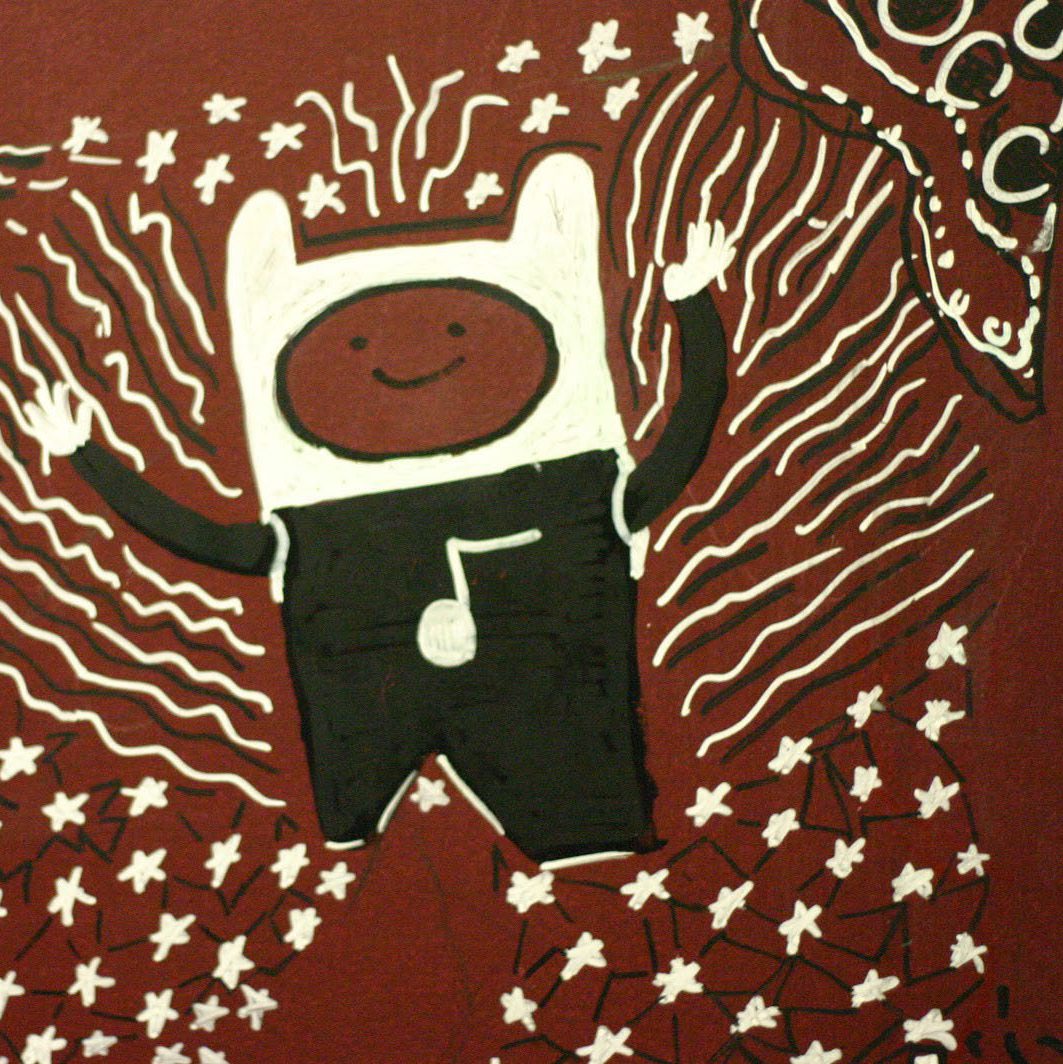
Since the autumn of 2013, I’ve had the unique opportunity to team up with the Under Pressure Festiva coordinator: Melissa Proietti, (M.Ed Educational Studies Concordia/current PhD student McGill) to help co-facilitate the Urban Arts After School Program at James Lyng High School located in Montreal’s Place St. Henri neighbourhood of the South-West borough. The program is part of a partnership between the YMCA and James Lyng’s CLC (Community Learning Centre), an extended dialogue formed between the school’s students and their surrounding community. Together, we offer the students a safe space and forum for discussion and the practice of urban visual arts, emphasizing the collaboration and communication process of the participants, rather than the end-product. Our diverse projects aim to create a safe and generative context within which collaborative art-making practice can put the youth and their ideas at the center of the process (Tobey & Jellinghaus, 2012, p. 128). This allows our students the opportunity to develop an awareness of their role as active participants in their school community and to ensure that all other school community members would be reminded of their presence and identity regardless of their status as compared to others (Proietti, 2010, p.70).
The 2013-2014 Urban Arts After School Program at James Lyng developed a narrative mural using meaningful and personal imagery chosen and developed by the group over a three month period. A dedicated group of twelve students ranging from grades seven through eleven, shared their collective stories. The students intertwined their individual voices through a collaborative mural on a locker wall, by filling in the negative space left by the title “Know The Ledge” with illustrations, paintings, and patterns. During a mentoring session with a visiting graphic artist, the students voted to use this quote as their inspiration.
School’s Stories The goal of community public artwork is to create a sense of ownership and pride in a place (Gude, 2000, p.11). According to post modern educator Olivia Gude, the effective community-based art mural cannot exist as truly an authentic narrative art piece unless the artists conceptualize, make the work and are also the audience (p.13). This article is the collective account of the experience of working together with a high school population to construct their locker room mural in Winter/Spring 2014, as well it reveals the stories and reflections on the process and creation from the students involved. I used Mary Jane Zander’s description of Peter London’s approach of “bearing witness” to help the selected students involved with the mural reconnect with the potential for meaning within their work (Zander, 2007 p.193). The “Know The Ledge” mural was a wonderful exercise in collaboration, as it displays a kaleidoscope of ideas and inspirations from more than the dozen students and staff. Everyone contributed to the design with their ideas to help reclaim a space in the school. Its accessibility lies in the simplicity of the mark-making, as well as the referencing of so many elements of visual culture from popular television programs, songs, films, and books.
The Design In lieu of starting on a typical indoor white wall, the students used a locker room wall that was already painted burgundy, the school color. Students created using white, black and gold paint markers, plus acrylic paint applied with brush, or aerosol can. The vast majority of the drawn and painted imagery found on the mural was selected and developed by the youth participants. The students had a thematic brainstorming drawing session in conjunction with a pattern-drawing activity with another visiting artist. In recent years, young people are being acknowledged as powerful resources: they are the makers, knowledge-creators, and teachers themselves, each with valuable ideas and capabilities to share with those around them (Curtis, 2008; Delgado, 2006). This is a factor Proietti and I emphasize, when facilitating the art workshops with our students. Their bountiful knowledge and creativity can be observed through their choice of imagery in the “Know The Ledge” mural. There are so many figures and forms to scan through, including familiar imagery that evoke memories of stories past and present.
We Come Together Tyrone, a veteran of the Urban Arts Program, no longer studies at James Lyng high school, but continues to come to the After School Urban Arts Program as an active participant and mentor to motivate his younger counterparts. When asked about the possible stories and meanings behind specific areas or imagery in the mural or his own particular contribution to it, Tyrone chose to instead address the mural holistically. He explains: “Just look at all the drawings and paintings. All done in many different styles, ranging in sizes, but yet they all come together and fit so beautifully. Since childhood, I never felt that I had to change my own individuality or conform. Like the school, the artwork accepts diversity and energy. We all just came together, and it works.”(personal communication, November, 2014) Tyrone held various formal leadership roles in his final year at James Lyng and embraced a very inclusive attitude towards everyone.
On Mentors Brian,* who now attends Dawson College in Montreal, was one of the first students of the group to begin to draw actual figures on the wall. He had joined us one afternoon with his own source imagery printed from the school’s library in hand, of what he considered a true embodiment of “knowledge.” He explains his process: “When we were discussing the ‘Know the Ledge” project, I thought of drawing some characters who are related to the archetype of the wise-old man like Merlin [the Wizard/Magician] from The Sword In the Stone or Ben Kenobi from Star Wars. The first character I decided to draw was the character Giles from “Buffy the Vampire Slayer” series because while the character fits in with the theme, he’s more relatable than the others I’ve mentioned. In the show, Giles acts as both the mentor and surrogate father to Buffy and her friends. What I find relatable about him is that while he and the others are close like a family, Giles doesn’t quite fit in with them socially. Giles proves himself useful to the team whenever trouble arises. When drawing him on the ‘Know the Ledge’ [mural], my favorite part of the process was trying to carefully capture his facial features (including wrinkles) as closely to his TV counterpart as possible.” (personal communication, November, 2014) Like the character Giles, Brian became an important resource of knowledge and expertise for his peers and friends when it came to collaborating on school-assigned video projects or collaborative art activities in his final year.
Art Heroes
Kevin, a grade 11 student, has a real passion for comic book art and had drawn many of his favorite cartoons and comic superheroes throughout the mural. I was delighted to learn that he had the strongest connection, not a fictional comic character, but to a real artist because her story resonated with him. She had overcome her own disability, to become one of the most recognizable artists of the 20th century. Kevin remarked, “I personally felt the strongest connection to the portrait I drew of Frida Kahlo. To me, she represents someone who succeeded in her art, and overcame her disability. I’m like that. I can relate to that.” (personal communication, October, 2014) Kahlo painted the events of her own life with symbolic elements and situations very much like this narrative mural, which contains the symbolic elements and stories of all those who were involved in creating it.
On Artistic Flow
Token was a recent transfer student and new addition to the James Lyng Urban Arts Club when we met in the winter. Initially perceived as shy and soft-spoken by his peers, Token was a steady participant to the mural creation. His miniscule drawings of characters and forms added a whimsical touch to the piece. It is safe to say, Token’s involvement with the ‘Know The Ledge’ mural helped lead to some extended opportunities to collaborate in greater-Montreal community artistic endeavors. Token has since been involved in a live tape art installation project at Breaking Curfew (a youth-driven arts party); the Oliver Herring hosted TASK Party at Concordia in June; and the 19th Annual Under Pressure Festival this past August. About his process, he commented, “The drawings and patterns I contributed to the mural were really random ideas that I thought up on the spot. I didn’t have any type of strict plan about how I wanted anything to look. I went with my thoughts in each moment and went with the flow, while knowing everything would turn out looking cool and interesting no matter what. I think the process in which I contributed some of my art to this project resembles me a lot as a person. I’m usually just going with the flow in life and I do many things in this life quite spontaneously and without having any specific guidelines.” (personal communication, November, 2014)
Hail to Haring:
Program veteran Shannon,* had been in the Urban Arts after school art program since it started four years ago. Another self-proclaimed shy student, her innate talent for illustration and design is something that will open up many opportunities for her in the future. She is currently studying Studio Arts at Dawson College and aspires to become an art therapist. As a veteran of the group, Shannon would often set the tone and ensure that her younger peers were comfortable or had ideas for drawings. She is responsible for a lot of the larger-scale imagery in the mural. She pays homage to an artist she admires and references in the mural. What resembles Keith Haring-inspired silhouette figures are found dancing amongst the patterns in various spots of the mural. Shannon discusses her intention, “I discovered Keith Haring this year and really enjoy his style. Although his art seems fairly simple it still fascinates me and I learned that his art was something very new at the time. He used it to make statements about the world and it spoke about death, war, sexuality, drugs, etc. His art was used as a strong voice for the community.” (personal communication, November, 2014) Keith Haring’s mass-appeal and accessibility has made him a favorite amongst street artist fans of all ages. He was an artist for the people and made it his mandate to be representative of a wider community than just the white-cube Fifth Avenue Gallery spaces in NYC. Haring’s contribution to the art of the 20th century is difficult to fully appreciate, because ultimately he transformed our idea of what art is. When once asked to state the values he was trying to impart in his work, Keith replied that he wished for “a more holistic and basic idea of wanting to incorporate [art] into every part of life, less as an egotistical exercise and more natural somehow. I don’t know how to exactly explain it. Taking it off the pedestal. I’m giving it back to the people, I guess. (Drenger, 1988, p. 53)”
Final Thoughts:
Like many of the urban/street artists who have influenced the culture, the Urban Arts After School Club plans and produces many public artistic interventions in and around the school for the entire student body to enjoy and participate in. Although not originally intended to be such an interactive piece, one can’t help but get lost in the intricacies of the Know the Ledge mural’s imagery. The mural was an opportunity for us all to share our stories and experiences amongst the group, as well as the school community-at-large. Our Visual Culture Art Education (VCAE) inspired approach to art education is successful with our given population as it places our students flush in the center of the creative process, “engaging them in opportunities to become critical thinkers and problem-solvers as well as artists and agents of change” (Tobey & Jellinghaus, 2012, p. 142). We look forward to planning further opportunities that allow our students to voice their stories within the context of their school community and surrounding environment; and allow for them to make informed decisions on their shared communal spaces.
Resources:
Curtis, K. (2008). Empowering youth: How to encourage young leaders to do great things. Minneapolis, MN: Search Institute Press.
Delgado, M. (2006). Designs and methods for youth-led research. Thousand Oaks, CA: Sage Publications.
Drenger, D. (1988) Art and Life: An Interview with Keith Haring, Columbia Art Review, Spring
1988.
Gude, O. and Huebner. J. (2000) Urban Art Chicago: A Guide to Community Murals, Mosaics, and Sculptures. Chicago: Ivan R. Dee, 2.
Proietti, M., Concordia University, & Concordia University. (2011). Creating urban art in a school setting. Montréal, Québec: Concordia University.
Tobey, A., & Jellinghaus, K. (2012). De (Fencing) with Youth: Moving from the Margins to the Center. The Journal of Social Theory in Art Education (32) (K. Staikidis, Ed.).
128-144.
Zander, M. J. (2007). Tell Me a Story: The power of the narrative in the practice of the teaching art. Studies in Art Education A Journal of Issues and Research, 48(2),189-203.
* Names of students under 18-years of age, have been changed to protect identity. The students selected their new names.